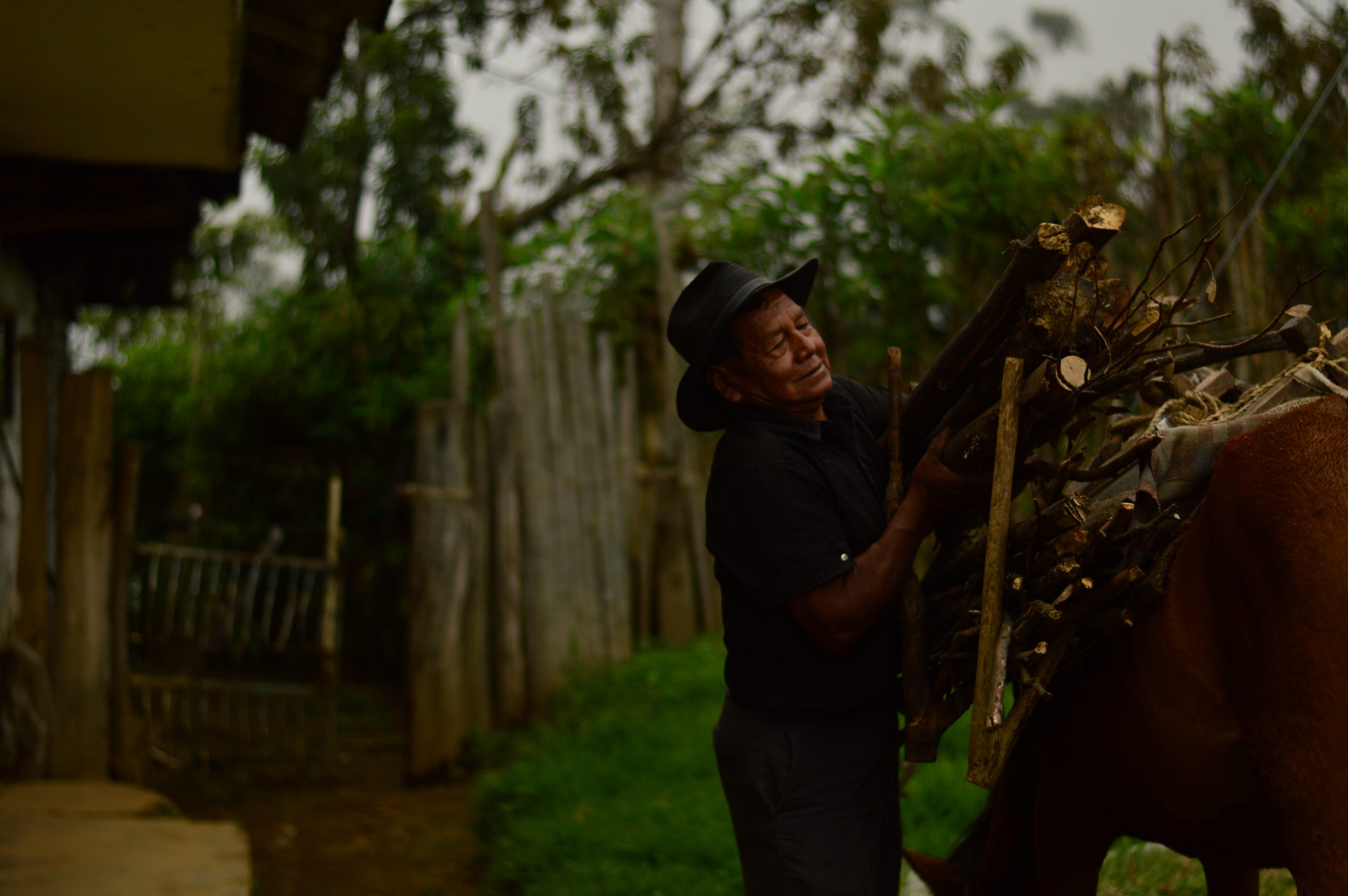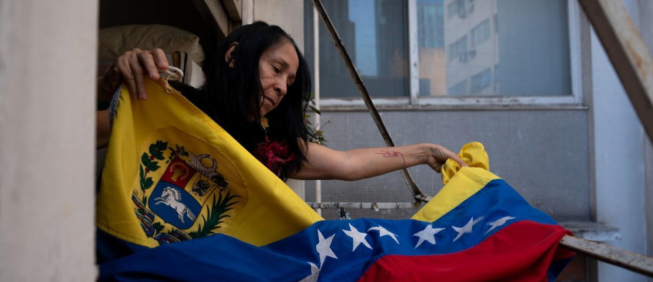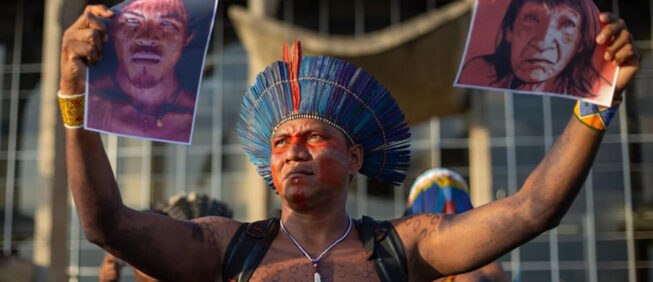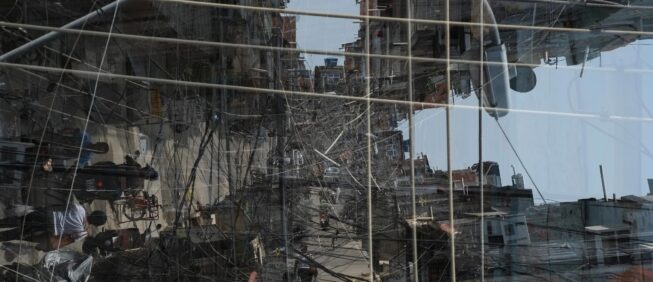Buen vivir and autonomy in latin american indigenous territories
Buen Vivir: Language, Creativity and Criticality
Salvador Schavelzon
Thea Pitman
| Brazil | UK |
20 de July de 2019


During 2018, a heterogeneous group of people – hailing from indigenous communities located in the present-day Northeast Brazil and Southwest Colombia, more or less formal third sector groups with a primary focus on indigenous empowerment, and from universities in the UK, Brazil and Colombia – came together to work on a research network project exploring the ways in which the discourse of “buen vivir” [good living] circulated in the indigenous communities in question. In Colombia, the project involved Nasa communities in the north of Cauca Department, particularly in the autonomous indigenous territory of Pioyá, plus the communication-action initiative Pueblos en Camino and the Universidad Autónoma del Occidente (UAO) in Cali. In Brazil it involved a network of communities across the states of Bahia, Sergipe, Alagoas, and Pernambuco, inter alia the Pankararu, Kariri-Xocó, Karapotó Plak-ô, Tupinambá de Olivença and several Pataxó communities from southern Bahia, working together with the Bahia-based NGO Thydêwá, and the Universidade Federal do Rio de Janeiro (UFRJ). Finally, in the UK it involved academics at the Universities of Leeds and Bristol and was supported by the Arts and Humanities Research Council’s ‘Global Challenges Research Fund’; an initiative which seeks to align its research funding priorities with those of the United Nations’ Sustainable Development Goals.
The topic of “buen vivir” was originally suggested by the NGO and adopted by others involved in the network as an area where research might be conducted alongside ongoing community initiatives to promote autochthonous values, beliefs and practices, initiatives that are crucially important given the volatile political contexts in both nation-states that threaten the survival of those communities and their alternative proposals for human social organisation and relations with their local environment (Colombia;Brazil). Such debates sought to critically interrogate the concept of "buen vivir" in the aftermath of its co-optation over the last decade by the governments of other nation-states in the region (Ecuador and Bolivia), and its growing co-optation by politicians in both Colombia and Brazil, as well as other non-indigenous actors such as the Catholic church in Brazil (for a fuller context, see Schavelzon, also in this issue). The research network also sought to explore what is at stake in the potential conflation of indigenous understandings of sustainability that are part and parcel of "buen vivir" and the top-down promotion of sustainability as something achievable within the development framework sponsored by the United Nations through the Sustainable Development Goals (for more detail, see Almendra and Rosental, also in this issue).
The project thus sponsored a series of events in the indigenous communities involved, as well as three international symposia to share knowledge and perspectives across as many network members as possible. The idea underpinning the indigenous community activities was to allow space for indigenous-led research by using the funding to support events and/or projects already in motion, using them to provide a suitable forum for the discussion of "buen vivir" and related terms. For Thydêwá, for example, "buen vivir" became a transversal theme cutting across virtually all of their projects in 2018, from the day-to-day discussions of their network of Indigenous Points of Culture (Pontos de Cultura) and their indigenous women’s network (Pelas Mulheres Indígenas), to a theme evident in more arts-and-culture-focused projects intended to improve relations between generations through the sharing of memories and knowledge (Memoria Viva), and to create indigenous electronic art (Arte Eletrônica Indígena). For Pueblos en Camino, the funding was used to sponsor a wide range of events, most of which focused on consciousness-raising and/or political mobilisation around how to practice "buen vivir" in autonomous indigenous communities in post-Peace Accord Colombia, or specific issues such as the human and environmental impact of the Hidroituango dam project.
What I want to focus on here is the importance of language – both the use of specific terminology in the dominant European languages in question, and the use of indigenous languages per se– as an essential component of a critical and creative approach to "buen vivir" that seeks to avoid co-optation. The Nasa community has a long history of resistance to co-optation by the state and one of the features of this is evidenced, not only by their conservation of their indigenous language, Nasa Yuwe, but by their determination to use the Spanish language in a way that resists easy assimilation into dominant structures. This is evident in the Asociación de Cabildos Indígenas del Norte del Cauca’sdivisionof its various different “working parties” into “tejidos” (weaves), a deliberately awkward term with respect to its relationship to standard organisational structures, but one that positions itself as specifically indigenous through its reference to weaving, a hugely important facet of Nasa cultural life. The use of unusual words and neologisms such as “pervivir/pervivencia” (“to pervive,” or “survivance”) and “sentipensar” (to feel-think) are also worthy of note: while not indigenous in origin, they have been adopted as distinctive features of the lexicon of indigenous discourse in Colombia over the last couple of decades. The popular expression “caminar la palabra” (“to walk the word”), also gives a sense of the self-awareness in the Nasa community with respect to the importance of words and how they may be mobilised.
When it comes to the discussion of "buen vivir", the term used in Nasa Yuwe is “wët wët fxi’zenxi” which is most frequently translated into Spanish not as “buen vivir,” but as “buenos vivires,” a plural concept. It is this plurality that seems crucial to me: it allows space for "buen vivir" to exist beyond that which is co-opted and pinned-down in official discourse. As Vilma Almendra observed during one of our international seminars, “I don’t think there is an exact or concrete definition of what ‘buenos vivires’ are.” Rather “buenos vivires” are “initiatives and practices that are beyond institutional frameworks”; “It’s not a formula, it’s not a closed concept; instead it’s a concrete practice that we have to embrace at some point in order to survive” (for more detail, see Almendra, 2017: 249-59).
In the case of the indigenous communities in Brazil involved in the research network, they were all declared officially extinct by the Brazilian government towards the end of the nineteenth century. They were encouraged to assimilate culturally and racially with other groups, to leave traditional beliefs behind and adopt the Catholic faith, to leave their indigenous languages behind as they were educated through the medium of Portuguese. While, over the course of the last hundred years, these communities have made significant advances in reasserting their indigenous identities and having their territories officially demarcated, in most cases it was far too late to rescue their languages. Nonetheless, there is evidence of linguistic reinvention currently going on in some of these communities. The most studied to date are the Pataxó communities of southern Bahia/northern Minas Gerais and their (re)creation of the Patxohã language (for more detail, see Bomfim and Franchetto). However, within the research network the Kariri-Xocó are also engaged in a similar process to creatively revive/reinvent a language which they refer to as Dzubukuá Kipeá. They have a language school for children in the community and they also use WhatsApp as a medium to distribute word lists and other materials to adults interested in developing their language skills. A key outcome of the research network has been the identification of this practice as a concrete example of "buen vivir" – of “kanewiá’ in Dzubukuá Kipeá – and to start to seek ways to support this process of community empowerment through linguistic “retomada” (reappropriation).
Cover photo: A Sketch of the Forms of Good Living of Pioyá, Cauca
BUEN VIVIR AND AUTONOMY IN LATIN AMERICAN INDIGENOUS TERRITORIES
Salvador Schavelzon
Translation
Charlotte Broadhurst and Thea Pitman
An Evaluation of Forty Years of Indigenous Politics in Latin America
The impetuous advance of Indigenous struggles in Latin America has, in recent decades, coincided with the arrival of democratisation in most countries. Since the 1980s, the political class has been faced with the pending issue of establishing new rights for Indigenous peoples and consolidating their territories. Policies of subordination, ethnocide, and forced or gradual assimilation were visibly overturned in “progressive” public opinion and beyond. This opened up political possibilities that would translate into state legislation in most countries, consistent with the approach encouraged by the United Nations.
Meanwhile, in Indigenous territories, harassment and exploitation would continue or even increase. However, it was no longer normalised or seen as something inevitable, at least in the opinion of the majority of people, and especially not in the communities themselves. These communities found new tools with which to avoid ethnocide, organising themselves and finding allies, where before they could only migrate or accept subordination to capitalism and its dynamic expansion and exploitation.
At this point in time, Indigenous peoples were seen as maintaining a way of life that had the right to be preserved, and governments started to recognise this right, at least formally. Meanwhile, Indigenous peoples worked hard to extend their organising capacities beyond their own communities, opening lines of communication with the rest of society. The same point in time saw the emergence of the “third sector” which was very open to the Indigenous agenda and worked to help legally formalise the rights of Indigenous individuals and communities. They did this by using the language of “white people” and by codifying in institutional frameworks Indigenous claims that sought to recognise and preserve ways of life and remnants of ancient civilisations that had been decimated and disarticulated by the modern world.
A new common sense, which abandoned the idea of the need to bring progress to populations that had nothing, came to be expressed in legal structures, public policies, and discussions of the issue in the press. The old social logics that lay behind the model of welfare, Fordist production, and a society that was structured by classes or masses, were unravelled. Together with neoliberal advances regarding subjectivity and life, there was now a place where a world of differences and autonomous forms that were disconnected from capitalism but operated within its framework, with symbolic power to question its fundamental logic, could find a way to survive at a time of the collapse in national sovereignty and of the ideological bases of modernity.
The powerful metaphor of progress, development, and civilisation prevails in Latin American society and its political class. However, formally at least, Indigenous communities were acknowledged as functioning in a very different way, contrary to the logic that had held sway for centuries following colonisation. The right to exist favoured the communities’ search for autonomy, guarantees of collective ownership of their territories and authorisation of alternative systems of law and health. Indigenous peoples were at the ready to create cultural expressions inspired by traditional rituals and aesthetics, destined for consumption by a dominant society that would now accept Indigenous peoples as producers of cultural content.
While the world of industrialisation collapsed and the promises of bourgeois society evaporated, Indigenous peoples demonstrated the validity of their lifeways in places like the Andes with its active community dynamics, or in the Amazon, with the resistance of lifeways linked to the rainforest. These forms of resistance and alternative approaches also have also managed to conceive of a new society in which alternative lifeways might configure into the reformulation of Leftist imagination. Instead of the progressively unimaginable reorganisation of the worker’s movement or the return of the all-saving State, we need to understand that this search for community lies beyond the State, at the margins of the reproduction of a society that had, in previous centuries, conducted the civilising and colonising process of territories that had resulted in the confinement or disappearance of Indigenous ways of life.
In this new era, Indigenous claims were, for the most part, interpreted through the lens of a multiculturalism espoused by those who were happy to offer inclusion as long as it did not interfere with their own lives. This was thus a limited, marginalising form of inclusion, as if Indigenous peoples could only be included once they had been decimated and, thus, considered harmless. It was certain that industrial capitalism and neoliberalism led by large corporations and the increasing prevalence of the logic of capitalist competition and valuation in all aspects of life and territories would continue unabated. However, criticism of this model, and signs of its exhaustion, would be apparent in both public opinion and in structural modifications made by governments experiencing moments of redefinition.
The capitalist norm would coexist with a change in vision, leaving behind the traditional, folkloric preservation of populations understood as being “things of the past,” instead of seeing the inevitable acceptance of Indigenous peoples as contemporary political actors. Like a stone in the shoe of neoliberalism (or even as part of neoliberalism itself, given that Indigenous peoples would not be free of contradictions and a hybrid relationship with the new society), Indigenous struggles would grow in strength in the new climate. This would be translated into State reforms and constitutional changes across Latin America, and Indigenous groups and their allies would take advantage of these in order to demand a change in the way the State conceptualised them.
The Indigenous communities themselves were responsible for this change, having resisted military attacks and the encroachment of capitalist economics into their territories, removing and destroying their resources, life cycles, and living spaces in its path. Defending themselves from a vast array of forms of misappropriation and from threats to worlds and ways of life that did not adapt to the logic of capitalism and modern civilisation, Indigenous movements appeared with force at the very moment that the world seemed ready to decree their ultimate demise.
The ultimate victory of development and modernisation, which seemed to be inevitable, did not come to pass. In fact, its very logic was proven to be insecure by the fact that all around us there are alternative, resistant, contestatory modes of existence. Since the 1980s, the struggles of Indigenous communities have become increasingly visible, taking various forms of resistance. Marches across multiple countries gave birth to great historical organisations of peoples and communities, formed by those excluded from formal institutions with only mobilisation at their disposal.
The 1990s would witness the rise of constitutional responses to the progress of Indigenous mobilisation. The UN, through the International Labor Organisation (ILO), would set out the blueprint for the incorporation of rights in territorial recognition as well as special culture-based rights in the constitutions of countries such as Brazil, Argentina, Colombia, and others. Indigenous marches, as an expression of new actors now visible to the centre of governmental power, were acknowledged by political systems now open to incorporating such demands — demands most often incorporated when they do not affect economic interests, but can be capitalised on as a symbolic response to a sector of society which is highly valued in progressive public opinion.
The influence of this agenda on processes of constitutional reform, however, would not stop Indigenous groups from continuing to align themselves with a Leftist, revolutionary framework inherited from the previous decade. Little by little, this would result in the convergence of popular programmes, great mobilisations and the consolidation of alliances between Indigenous peoples, intellectuals, peasant groups, national and international social movements, trade unions, and anti-neoliberalist members of the general public.
Liberal governments would incorporate Indigenous rights, but without considering the collective community or autonomous dynamics that were typical of the very people that they were trying to include.In a second phase of Indigenous mobilisation that was critical of the way in which rights had been initially assimilated and that focused on the consolidation of self-determination and territory, a new generation of resistance would gradually come into being — one which did not exclusively look to the State as the provider of policies, land titles, and welfare. Groups from the Andes and the Amazon, the Chaco, Patagonia and even in the cities, would begin to utilise new strategies of resistance and the construction of autonomous territories.
In the 1990s, Neo-Zapatismo in Chiapas would become a point of reference for those looking for ways to form alternate worlds where communities would not be subsumed by capitalism and modernity. Moreover, it would be used as a reference for the possible meeting of different worlds, revealing the blinkered political views and linear, homogeneous, hierarchical thinking of dominant society and its ruling classes.
Recovering forms of community that had always enjoyed significant levels of autonomy would uncover a type of organisation that avoided turning to the State for solutions, instead delegating autonomy and offering the possibility of a world not subordinated to the market and the nation-state. In Chiapas and other places, a range of demands would be constructed, including cosmologies and non-modern ways of life as mobilising components and an authentic presence of Indigenous “otherness” in their struggles.
This new age of Indigenous struggles, which included criticisms of the way in which the State and its society were incapable of understanding community and autonomous forms, would result in a series of State reforms related to Indigenous issues. After the combination of multicultural agendas and the ultimately unpopular liberal governments that sponsored them, it would be time for more populist, nationalist governments to come to power between 1999 and 2005, tailoring policies for Indigenous communities to suit their own style of government.
Within their intellectual and political framework, these governments included sectors of the Left and NGOs, some of which had been a direct part of the consensus in favour of recognising the rights of Indigenous peoples since the 1980s. Once in government, however, this position was not treated as a priority. In fact, it was postponed or abandoned by a social agenda that preferred to negotiate with the masses, guaranteeing electoral support in exchange for social policies. In many places, this translated into a boom in access to consumption for the poorest sectors of the population.
The gradual abandonment of the alliance of the Left, or of progressivism, with Indigenous organisations, which in the heat of the struggle had found ways to confront paternalistic State logic and had sought to create possibilities for the development of autonomy, led to major political fallout. In some cases, such as Bolivia and Ecuador, this fallout occurred instead later on, after the rights of Indigenous peoples had seen unprecedented advances in constitutional terms in 2008 and 2009. These governments held power at a time when commodities commanded high prices, and this gave rise to public infrastructure works programmes and mining projects, which, in some cases, impacted Indigenous territories. This created a situation where the initial ambiguity of trying to balance an Indigenous agenda with the capitalist development of peripheral countries hungry for any kind of investment transformed into an acceptance on the part of the progressives of a conservative, capitalist, developmentalist consensus as a form of government.
Given this context, there would be a clear a rupture between the Indigenous movement and the progressive sectors which, when not in power, had been in favour of introducing Indigenous rights. The experience of being in government was, thus, frustrating in terms of their expectations of progress in making newly-enshrined rights truly effective.After criticising the way that these rights had been incorporated in name only, without any concrete consequences for the legislation introduced in the 1990s, the Indigenous movement found progressivism to be yet another game of elite politics, offering inclusion in purely symbolic terms.
It was within this scenario, and as part of the evolution of Indigenous resistance itself, that the question of autonomy would become central to Indigenous progress. This can be seen as a sort of maturation, given that dealings with the State had shown themselves to be treacherous. The Zapatistas were the first to start focusing on the idea of autonomy, having seen how both progressives and conservatives shut off access to the various powers of the State, thus closing the door to agreements that had been signed to end the conflict. Neither Congress, the courts, nor the presidency would act on promises made by politicians; promises made to look good in terms of their attitude to Indigenous peoples, whose right to existence is, today, recognised by a considerable part of the electorate.
In Bolivia, even after reaching the government and being directly involved via an alliance of rural Indigenous peoples in redrafting the constitution, the result would not be any different. Minority groups from far-flung jungles and rainforests, found themselves in the same frustrating situation, convinced of the need to build autonomous communities in order to defend themselves at thepolitical level. Despite Peronism’s historic openness towards the Indigenous cause, in Argentina, the Kirchnerists ignored conflicts and demands that involved their allies either in the provinces or in the oil and mining ventures that they promoted.
Governments on the margins of the progressive wave, such as those in Colombia, Mexico and Peru, did not approach the matter any differently. The development consensus set the State against Indigenous peoples, generating a new series of protests, marches and organisations, comparable with those of the 1980s and 1990s, with demands for legal titles to their lands and new rights. Now, it became about confronting a direct threat to their territories. A noteworthy example is that of the Arco Minero project in Venezuela, where land concessions have been granted over huge areas without taking into account national parks, environmental reserves, or Indigenous territories. In these cases, official propaganda offered work, development, economic growth and the insertion of the country into the global economy.
Progressivism would not take on the issue of major infrastructure projects or the advancing frontiers of agribusiness and mining, but would instead ask how these would coexist with secretariats or ministries concerned with defending Indigenous rights, albeit from a top-down, multiculturalist or clientelist position, all the while working with social aid projects that were blind to the differences and particularities of Indigenous society. In Brazil, for example, the introduction of money and goods through the expansion of social programs under the Workers' Party government torenative society to pieces. It brought the arrival of capitalism, hydroelectric projects and soyabean monoculture, resultingin the expulsion and displacement of populations.
Since the departure of progressivism, governments like that of President Jair Bolsonaro in Brazil have explicitly confronted Indigenous communities, taking advantage of the fragility of progressivism’s Indigenous politics. They are explicitly aligned with businesses interested in the exploitation of the Brazilian territory. In addition, President Mauricio Macri in Argentina has aligned with the Chilean political stance against Mapuche communities, in which both liberals and conservatives have criminalised protests and defended territorial expropriation in the name of economic ventures.
Unambiguously, Bolsonaro would declare that the real Indigenous person is the one who is integrated into society, thus returning to a pre-democratisation consensus but also expressing the common sense of business that progressivism allowed to prevail in its alliances and government logic. The failure of progressivism to find a national development project that included Indigenous peoples beyond mere rhetoric would give way to the sincerity of capitalist interests that evidenced little compatibility with previous policies beyond a timid ambiguity in the terms of political discourse on the subject.
Autonomy and “Buen Vivir”
Faced with the combined failure of progressivism and the right to address Indigenous demands, and as the result of a decades-long political search for the construction of territories through political demands and legislation presented in the political space of nation-states, two agendas have emerged as Indigenous strategy.
As policies of the Indigenous organisations themselves, rather than the State or the third sector, “Buen Vivir” has opened up debate around the development model, drawing on the community experience of production and economic sustenance. In relation to this project of recovery and reinvention of those economic forms removed from the dynamics of inclusion in the market economy, proletarianisation, or dependence on state monetary resources, the search for autonomy stands out as a claim that seeks to guarantee political control over territory and the full validity of Indigenous forms of justice and independent organisation.
In a criticism borne of the experience of direct or more sophisticated forms of control and tutelage, “Buen Vivir” and autonomy, as policies of Indigenous organisations rather than the State, address the challenges of self-defence and of development from below without expecting anything from above.
With the new Right in power, progressivism has been returned to a position of resistance which, nonetheless, presents itself as nostalgic yet ineffective. It has retained its habit of organising protests from above, characteristic of the phase prior to its arrival in power, and it has failed to do any soul-searching — this, despite years of experience of confrontation exposing progressivism’s limitations when it comes to thinking beyond the framework of development.
From the viewpoint of the communities, one can see how the Left, now out of power, is again calling on social forces, including Indigenous peoples. However, once again, they are failing to address issues such as the crisis in our models of civilisation, environmental catastrophes, the failure of modern institutions and their inability to tackle, or even start to engage with collective, non-modern and autonomous forms of political representation.
Autonomy and “Buen Vivir” were not exempt from being utilised during the period of constitutional reforms promoted by progressivism and their subsequent implementation(that is, in a conventional sense that understood such terms to refer to public policy for communities).The State proposed “Buen Vivir” in public policies that it had previously called “policies for development.” It either presented multiculturalist legislation that recognises, but does not really allow, full territorial control, as “autonomy”, or it incorporated different forms of government to those of modern institutionality without acknowledging a possible rupture in the way in which these different forms organise the world.
However, non-co-opted sorts of autonomy and “Buen Vivir” are political forms that have always existed within Amerindian communities. For these communities, politics, justice, economy, religion, and cosmology are limiting terms thatchop the world up into distinct fields. This chopped-up world of differentiated areas is limited in comparison to a world of interconnection where, not only these forms of political discourse, but also the essential, modern distinction between humanity and nature, is questioned.
Derived from the political experience of the last several decades, a continuation of centuries of resistance and attempts to construct alternative societies, these forms of resistance are reactivated through the use of three terms that were gaining space and political force in national contexts where the Indigenous were waging battles on several fronts vis-à-vis their territories, the constitution, and their cultural practices. Although not entirely cut off from the rest of the world and capitalist modernity, Indigenous society proposes to remain whole and refuses to disappear in the face of continuous attacks. It thus expresses itself as an anti-colonial struggle.
Indigenous peoples have also developed a cosmopolitan agenda, insofar as they refuse to be part of a society that is structured around exploitation and consumption, instead seeking to build autonomous communities where even what we understand as the world, as nature, as society, becomes political material with which to oppose the modern world and instead encourage the development of community life. Although this is an ancestral construction, today it is translated into political debates that stretch beyond Indigenous society, and in which the inclusion of non-humans and the elaboration of political structures that account for collective subjects and territoriality are part of the discussion.
Since “Buen Vivir” and autonomy have been entirely conceptually reinvented as axes in Latin American Indigenous politics, it is possible to catch a glimpse of the strengthening of a new model of mobilisation and Indigenous political battles, establishing new ways of thinking about the defence of territory and other disputes with economic powers and with the State. A reading that takes into account the continuation of colonialism alongside anti-capitalism and the opportunity to question the functioning of the modern world (represented by agribusiness, evangelical missions in communities and public policies) gives rise to struggles that neither prioritise the ownership of land by individuals or families nor propose juridical or constitutional changes. These are cosmopolitical battles based on the defence of water sources, jungles, ways of life, and non-agroindustrial production (in contrast with certain rural movements). They also widen political imagination to a world open to non-human beings and relationships with the environment known to be more complex than the outdated concepts of development, exploitation of natural resources, or care for the environment allow for.
Bibliography
Almeida, I. 2008. El Estado plurinacional: valor histórico y libertad política para los indígenas ecuatorianos.Quito: Abya-Yala.
Clavero, B. 2008. Geografía jurídica de América Latina: pueblos indígenas entre Constituciones mestizas. Mexico City: 21st Century.
De Sousa Santos, B., and Exeni, JL, eds. 2012. Indigenous justice, plurinationality and interculturality in Bolivia . Quito: Abya-Yala & Rosa Luxemburg. Available from: http://www.boaventuradesousasantos.pt/media/Justicia%20ind%C3%ADgena%20Bolivia.pdf.
Farah, I., and Vasapollo, L., coord. 2011. Vivir Bien: ¿paradigma no capitalista?La Paz: CIDES-Sapienza de Roma-OXFAM.
Gudynas, E., and Acosta A. 2011. “El Buen Vivir más allá del desarrollo”, Qué Hacer, 181. Lima: DESCO, pp. 70-81. Available from: http://www.gudynas.com/publicaciones/reportes/GudynasAcostaBuenVivirDesarrolloQHacer11.pdf .
Larrea, AM. 2010. "“El constitucionalismo post-neoliberal y el Sumak Kawsay”, in SENPLADES, ed., Los nuevos retos de América Latina: socialismo y Sumak Kawsay. Quito: SENPLADES, pp. 15-28
Larrea, AM. 2010. "“El constitucionalismo post-neoliberal y el Sumak Kawsay”, in SENPLADES, ed., Los nuevos retos de América Latina: socialismo y Sumak Kawsay. Quito: SENPLADES, pp. 15-28
López and Rivas, G. 2004Autonomías democracia o contrainsurgencia. Mexico City: Era.
Ospina, P. 2010. “Estado plurinacional y autogobierno territorial: demandas indígenas en Ecuador”, in González, M. et al., La autonomía a debate: autogobierno indígena y Estado plurinacional en América Latina. Quito: FLACSOGTZ-IWGIA-CIESAS-UNICH, pp. 201-218.
Schavelzon, S. 2012. El nacimiento del Estado plurinacional: etnografía de la Asamblea Constituyente de Bolivia. La Paz: Plural-CLACSO-CEJIS-IWGIA.
________. 2014. Plurinacionalidad y Vivir Bien/Buen Vivir: dos conceptos leídos desde Bolivia y Ecuador post-constituyentes.Quito: Abya Yala.
Tapia, L. 2002. La condición multisocietal: multiculturalidad, pluralismo y modernidad. La Paz: Muela del Diablo.
Yampara, S. 2001. Suma Qamaña: la comprensión indígena de la Vida Buena. La Paz: PADEP-GTZ.

Thea Pitman | |
Thea Pitman Senior lecturer and researcher in Latin American Studies, based at the School of Languages, Cultures and Societies of the University of Leeds, United Kingdom, specialising in the study of Latin American digital cultural production, with a special interest in issues of race, ethnicity, and gender, as well as indigenous politics and cosmovisions.
t.pitman@leeds.ac.ukSalvador Schavelzon | |
Salvador Schavelzon Lecturer and researcher in Social Anthropology at the Universidade Federal de São Paulo, specialising in the study of Andean-Amazonian peoples’ political processes; Indigenous thought and cosmopolitics; plurinationality, processes of autonomy, Buen Vivir and alternatives to development.
schavelzon@gmail.com







